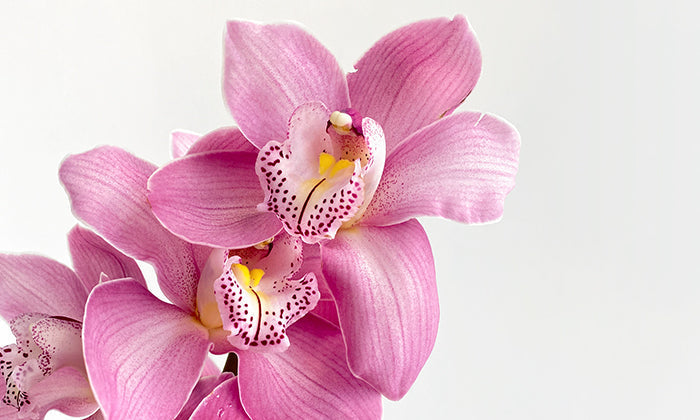
Apart from the Merlion, the Orchid has been a prominent symbol of Singapore ever since it was selected as the national flower in 1981. However, not many of us know exactly why or how that happened. Sit back and let us get you up to speed on everything and anything about our nation’s precious bloom.
Origin of the Orchid
So… where did the Orchidaceae (a.k.a. Orchid) originate from? Research has shown that it first appeared almost 200 million years ago and has since spread from one end of the globe to another!
The name of this exotic flower came from the Greek word “orkhis”. It was named by Theophrastos, an ancient Greek botanist who noted that its underground tubers resembled that of the male anatomy.
Today, you can find the Orchid growing naturally around the world, especially in places with tropical climates. They are highly versatile and capable of blooming in almost all kinds of environments except for extremely dry areas. Being the largest family of plants to exist, there are currently 25,000 – 30,000 known species of Orchids!
Really makes us wonder what their family tree would look like…
Orchids in Ancient History
According to Greek mythology, Bacchus (the God of Wine) invited his friend Orchis (son of a nymph and satyr) over to his palace for a luxurious banquet. Among the many attendees present at this feast were numerous young and beautiful hand-maidens. An intoxicated Orchis took a liking to one of them and forcefully made advances to her. Bacchus did not excuse his friend’s insolence and chopped him up to bits without hesitation. The pieces of Orchis were then widely scattered and wherever they fell, an Orchid grew.
Orchids were seen by the ancient Greeks as a provider of good health and strength; men were given these flowers to enhance their fertility, whereas the women believed it would bear them sons if they were consumed.
These flowers weren’t only mentioned in Greek myths, but in Asian culture as well! Chinese philosopher and politician, Confucius, adored and kept Orchids in his room, and even wrote a poem about their pleasant fragrance:
“The Orchids grow in the woods and they let out their fragrance even if there is no one to appreciate it. Likewise, men of noble character will not let poverty deter their will to be guided by high principles and morals.”
In addition to Chinese poetry, Orchids were also used in traditional Chinese medicine as remedies to illnesses involving the lungs and to calm coughs.
Orchids Native to Singapore
Did you know that there’s an estimate of approximately 224 species of Orchids recorded as native in Singapore? Unfortunately, most of them are considered Nationally Extinct or Critically Endangered, leaving only about 60 species remaining. Featured below are a few of our favourites to use in flower arrangements!

Aranthera James Storie
The Aranthera James Storie is a fiery red Orchid that was first created in the Singapore Botanic Gardens by then-director Richard Eric Holttum, all the way back in 1939!

Oncidium Orchids
Oncidium Orchids are otherwise known as Dancing Lady Orchids or Golden Shower. How exactly did this flower earn such peculiar names? Well, they have unique petals that resemble that of a lady dancing and these blooms also look like a shower of gold when they’re all bunched up!

Mokara Orchid
The Mokara Orchid comes in many different colours and is a special bloom that is the result of crossbreeding three different types of Orchids – the Ascocentrum, Arachnis and the Vanda Orchid.

Meet Vanda Miss Joaquim
The Vanda Miss Joaquim (Papilionanthe Miss Joaquim) is Singapore’s national flower. In 1981, it was selected among 40 other flowers, 30 of which were Orchids. Thanks to its distinctive colours, hardiness and strength, ‘Agnes’ best represented Singapore’s spirit and was therefore selected!
Named after its Singaporean breeder, Miss Agnes Joaquim, this special Orchid is a hybrid of two different species, Vanda hookeriana and Vanda teres. It’s the world’s first vanda hybrid and Singapore’s first Orchid hybrid.
Recent research shows that the two aforementioned Orchid species actually belong to the genus Papilionanthe. Henceforth, the botanical names for these flowers were changed to Papilionanthe teres and Papilionanthe hookeriana. The same went for our national flower, which is currently known as Papilionanthe Miss Joaquim. However, many still refer to it as Vanda Miss Joaquim.
To see these gorgeous flowers in the flesh, you may find them growing in these places: The National Orchid Garden, the Botanic Gardens, the Mandai Orchid Gardens and the Vanda Miss Joaquim Park at Tanjong Pagar.
What makes Orchids special?
Besides having a massive range of species and appearances, Orchids also have a special pollination process. Don’t be deceived by their charm and good looks!
Orchids are known for luring the pollinator with nectar and “tricking” it into pollinating them. The insect is attracted to the nectar, drinks it and moves to the next flower without even noticing that pollen has been deposited onto its body. When they visit the same species of Orchid, the pollen is transferred and fertilisation occurs. What a smooth criminal!
The deceit doesn’t stop there. Other Orchid species also deceive pollinators to attract them. Bee Orchid flowers have a unique petal that’s shaped like a female solitary bee. The flower attracts and then attaches pollen to the male solitary bees who try mating with it but in vain.
In other words, Orchids are smart AND attractive. They really hit the genetic lottery!
The symbolism of Orchids and their Different Colours
In Singapore, Orchids are a symbol of the nation’s multiculturalism because of the countless hybrids that exist. They convey harmony among different ethnic groups, including foreign visitors. While this bloom may be a national symbol, the Orchid stands for many other things: Fertility, charm, luxury, elegance, and lastly, love.
Know someone who just got hitched? These flowers make a great gift for married couples!
Now we know what Orchids generally symbolise, but their different colours possess a diverse range of symbolisms. To help you decide on which colour(s) would best suit your recipient, here is a list of the various Orchid colours and what they mean:

Meaning of Purple Orchids
In horticulture, purple Orchids are referred to as the ‘true queen’, and rightfully so! They are usually associated with royalty and power, making it an appropriate gift for someone that you admire and respect.

Meaning of White Orchids
White Orchids are perfect for weddings, engagements or christenings as they signify purity, innocence and chastity.

Meaning of Red Orchids
Most people associate the colour red with passion, love, affection and romance – the red Orchid is no different. Racking your brains to find ways to finally tell a special someone how you feel? Send them a bouquet of burning red Orchids 😉

Meaning of Yellow Orchids
The colour yellow typically embodies positivity and all things that make you feel warm and fuzzy. Yellow Orchids are a sign of new beginnings in life or friendship.

Meaning of Blue Orchids
Naturally blue Orchids are the flower version of a rare Pokémon. These blooms are extremely hard to find and come by, therefore signifying rarity, strength, spirituality, peace and calm. Due to its uncommonness, most blue Orchids you see are artificially dyed. Would you go on an adventure to find a naturally blue Orchid?
Orchid Fun Facts
- Pink Orchids are usually gifted to celebrate the 14th and 25th anniversary of wedded couples.
- Most Orchids are dependent on a single species of pollinator (bird, bee or insect). Should that species be eliminated, the Orchid that depends on it will be threatened by extinction. Therefore, it’s crucial that we do our part to protect these magnificent flowers.
- Orchids grow in every continent except Antarctica.
- The world’s smallest Orchid is only 2mm wide (the size of a dime) while thelargest weighs more than 50kg!
- The only species of Orchid to be commercially grown for its vanilla bean is the Vanilla Orchid.
- Orchids are symmetrical and can be split into two perfect halves.

Orchid Care 101
Orchids in general are delicate blooms. Once they’re cut, they require a different kind of attention as they tend to be more fragile. How long they last vary depending on the species. Let us walk you through the dos and don’ts of caring for cut Orchids.
How to Care for your Cut Orchids
All flower stems are sealed up at the ends, so cutting them actually allows the Orchids to take in freshwater.
- Once you’ve unpacked your flowers, find a pair of sharp scissors (or floral shears) and trim the stems at a45-degree angle. Sharp scissors/shears ensure that you do not smash stems. Any damage done to them may disrupt their hydration process.
- An angled cut increases the surface area of the stems, allowing them to absorb more water at a time—keeping the flowers more hydrated. Additionally, it ensures that the stems do not sit entirely flush against the bottom of the vase – which can prevent the flowers from absorbing the water that they need.
- Before you place your flowers in the vase, make sure to remove any leaves that may come in contact with the water! Leaves in water can breed bacteria and shorten the vase life of your flowers.
- Once you’ve done so, place your beautiful blooms in the vase of water! Let the Orchids sit in the water for 10 minutes before putting flower food in. Alternatively, you maycreate your own mixture for Orchid plants. For more details on general cut flower care, view ourFlower Care Guide.
Where is the best place to keep an Orchid?
Avoid placing your Orchids directly under sunlight. It’ll dehydrate and cause them to lose their colour. You may wish to put them somewhere with a lot of natural light instead. Super dry or cool areas are not ideal either. The preferred humidity levels are between 55 – 75%, and to maintain this, you can also consider using a mister on the Orchid’s leaves or putting the blooms in a room with a humidifier.
To keep your Orchids fresh longer, don’t forget the water! Orchids can’t be given too much or too little water. The best way of checking if your bunch needs water is to assess their leaves, stems, and petals. If they look dull, grey, or yellow, more water is needed.
And…That’s a Wrap
Orchids are flowers that definitely stand out from most others due to the reasons above. We’ve discussed the history of Orchids, how and why they became Singapore’s national flower, what they symbolise, and how to care for them properly.
Do you appreciate our country’s bloom more after this read? Check out our Flower Dictionary for more flower fun facts!



